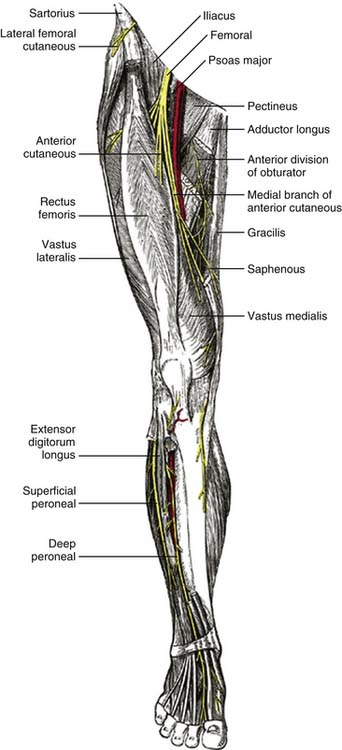27 Lower Extremity
Saphenous Nerve Block
Anatomy of the Saphenous Nerve
The saphenous nerve is the largest cutaneous branch of the femoral nerve. Sensory fibers from L3 and L4 levels contribute to this pure sensory nerve.1,2 The saphenous nerve branches off the posterior division of the femoral nerve and descends anteroinferiorly through the femoral triangle, lateral to the femoral sheath, anterior to the femoral artery and posterior to the aponeurotic covering of the adductor canal (also known as Hunter canal, subsartorial canal).1,2 It then exits from the adductor canal, descends under the sartorius muscle, and then courses around the posterior edge of the sartorius muscle at its tendon portion. In the medial aspect of the knee, the saphenous nerve descends vertically behind the sartorius muscle, pierces the fascia lata and becomes subcutaneous.1,2 At this level, the infrapatellar branch pierces the sartorius muscle and courses inferiorly to the infrapatellar region and innervates the skin in front of the patella. The infrapatellar branch communicates with the anterior cutaneous branches of the femoral nerve above the knee, and with other branches of saphenous nerve below the knee, as well as branches of the lateral femoral cutaneous nerve on the lateral side of the knee, forming the plexus patellae.1
The remaining course of the saphenous nerve then passes down along the medial aspect of the tibia, accompanied by the great saphenous vein and, divides into two branches at the lower third of the leg.1 One of the branches of the descending portion of the saphenous nerve courses along the medial border of the tibia and ends at the ankle, whereas the other branch passes anteriorly to the ankle and is distributed to the medial aspect of the foot, reaching as far as the metatarsophalangeal joint of the great toe and communicating with the medial branch of the superficial peroneal nerve (Fig. 27-1).1 The saphenous nerve supplies sensory innervations to the anterior medial aspect of the leg, including the medial malleolus (Fig. 27-2).1,2

Figure 27-1 Anatomy of saphenous nerve.
(From Williams PL, Warwick R: Gray’s Anatomy, 36th ed. Philadelphia, WB Saunders; 1980.)

Figure 27-2 Saphenous nerve innervation area.
(From Williams PL, Warwick R: Gray’s Anatomy, 36th ed. Philadelphia, WB Saunders; 1980.)
The adductor canal, the entrapment site for the saphenous nerve, is located approximately 10 centimeters proximal to the medial femoral condyle. It is an aponeurotic tunnel in the middle third of the thigh, extending from the apex of the femoral triangle to the opening in the adductor magnus. It courses between the anterior compartment of the thigh and the medial compartment of the thigh. The vastus medialis muscle lies anteriorly and laterally, whereas the adductor longus lies posteriorly. The content in the canal includes the femoral artery, femoral vein, and branches of the femoral nerve, the saphenous nerve, and the nerve to the vastus medialis muscle). It is covered by a strong aponeurosis that extends from the vastus medialis, across the femoral vessels to the adductor longus and magnus. The sartorius muscle lies on the aponeurosis.2
The adductor canal can be located by palpating along the anteromedial aspect of the vastus medialis muscle and then sliding posteriorly until the edge of the sartorius muscle is felt. The adductor canal is located directly beneath this point.2,3








